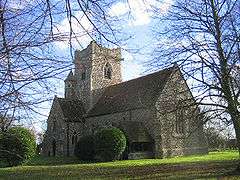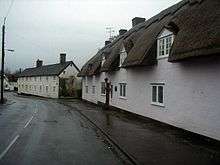Pleshey
Pleshey is a village and civil parish in the Chelmsford district, in the county of Essex, England, just to the northwest of Chelmsford. The population of 373[1] includes the separate civil parish of Mashbury.
| Pleshey | |
|---|---|
 Holy Trinity Church, Pleshey | |
 Pleshey Location within Essex | |
| Population | 373 (2011)[1] |
| OS grid reference | TL665145 |
| District |
|
| Shire county | |
| Region | |
| Country | England |
| Sovereign state | United Kingdom |
| Post town | Chelmsford |
| Postcode district | CM3 |
| Dialling code | 01245 |
| Police | Essex |
| Fire | Essex |
| Ambulance | East of England |
| UK Parliament | |
William the Conqueror gave Pleshey, in the parish of High Easter (southwest of Braintree), to Geoffrey de Mandeville. At Pleshey, Mandeville built his caput (centre of administration and main home) of the many villages in Essex given to him by the king. Later, his grandson, another Geoffrey, was made Earl of Essex by King Stephen.
The modern village

Traditionally an agricultural community, most householders today are commuters. Although the village has lost its shop and post office within the last 30 years, Pleshey still has a village hall, playing field, tennis court and children's play area. The attractive appearance of the village and the castle draws a manageable number of visitors, especially in the summer months.[2] Pleshey is home to the Chelmsford Diocesan House of Retreat, which was established in 1927 in a former convent for Anglican nuns.[3] The parish church, the Church of the Holy Trinity, retains some arches from the former chapel founded in 1394, but was otherwise totally rebuilt in 1868. It is a Grade II* listed building.[4] The 19th century Leather Bottle Public House is Grade II listed and sits in a group of other listed houses.[5]
Pleshey's historical significance
For a long time, Pleshey Castle was an important place in English history. Through inheritance, Pleshey Castle became the main castle of Henry de Bohun, 1st Earl of Hereford, and his wife, Maud, sister and heiress of William de Mandeville, Earl of Essex. From this marriage de Bohun's son Humphrey became Earl of Essex (27 Aug 1236) as well as Earl of Hereford and Hereditary Constable of England. Generations of de Bohuns resided here, with Pleshey as their caput manor. Humphrey de Bohun VIII (4th Earl of Hereford and 3rd of Essex (1275?-1322) on 14 Nov. 1302 married Elizabeth, the daughter of Edward I, King of England. Some of their children were born at Pleshey. Humphrey VIII was killed at the Battle of Boroughbridge in 1322, rebelling against King Edward II.
In 1327, Pleshey Castle became the primary residence of Humphrey VIII's eldest surviving son, John de Bohun, created Earl of Hereford and Essex. He died in 1336 without an heir and the castle passed to his brother, Humphrey IX, Earl of Hereford and Essex (d. 1361). The youngest of the brothers, William de Bohun (d. 1360), became the leading commander of the early part of the Hundred Years War, devising the tactics that won English victories at the Battle of Morlaix (1342), the Battle of Crecy (1346), and the Siege of Calais (1347), and was created Earl of Northampton.
Humphrey IX never married and Pleshey was inherited in 1361 by William's son and heir, Humphrey de Bohun X (b. 1342), last male heir of the direct line. This Humphrey inherited both his uncle's and his father's titles and became Earl of Hereford, Essex, and Northampton. His only heirs at his death on 13 January 1373 were two young daughters, Eleanor and Mary.
Between 1361 and 1384 a group of Augustinian friars created the de Bohun manuscripts at Pleshey Castle; eleven books, one of them a Psalter, celebrating Mary de Bohun's marriage to Henry Bolingbroke, the future Henry IV, King of England. The Mary de Bohun Psalter is now in the Fitzwilliam Museum. Mary, who died before her husband became king, was the mother of Henry V, of Agincourt fame.
The castle then passed (through the marriage of Eleanor) to Thomas of Woodstock, Duke of Gloucester, the youngest son of Edward III. His nephew, Richard II, outraged by his uncle's opposition, had him arrested at Pleshey and taken to France. Two years later the Duke of Exeter was taken to Pleshey Castle and executed for plotting against the king.
Pleshey Castle's claim to fame includes Shakespeare's play Richard II, in which Thomas of Woodstock's widow asks for a visit from Edmund of York:
- Bid him – O, what?
- With all good speed at Plashy [sic] visit me.
- Alack, and what shall good old York there see,
- But empty lodgings and unfurnished walls,
- Unpeopled offices, untrodden stones?
(Richard II, Act 1, Scene 2, Lines 65–69)
See also
Bibliography
- Bigelow, M. M. “The Bohun Wills” I. American Historical Review (v.I, 1896). 415-41, v.II (1897). 631-649.
- Cokayne, G. (ed. by V. Gibbs). Complete Peerage of England, Scotland, Ireland, Great Britain and the United Kingdom. London:1887-1896. Vols. II, V, VI, IX: Bohun, Essex, Hereford, & Northampton.
- Dictionary of National Biography. Vol II: Bohun. London and Westminster.
References
- "Civil parish population 2011". Neighbourhood Statistics. Office for National Statistics. Retrieved 5 September 2016.
- "Pleshey Village Design Statement". Pleshey VDS Steering Group. 2003. Retrieved 22 June 2017.
- "The History of Pleshey". www.retreathousepleshey.com. Chelmsford Diocesan House of Retreat, Pleshey. Retrieved 22 June 2017.
- "Church of Holy Trinity - A Grade II* Listed Building in Pleshey, Essex". www.britishlistedbuildings.co.uk. British Listed Buildings. Retrieved 22 June 2017.
- "The Leather Bottle Public House - A Grade II Listed Building in Pleshey, Essex". www.britishlistedbuildings.co.uk. British Listed Buildings. Retrieved 22 June 2017.
External links
| Wikimedia Commons has media related to Pleshey. |